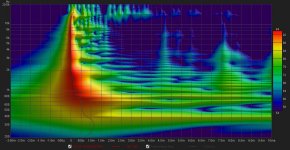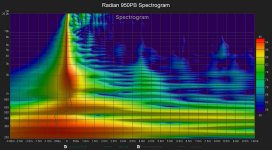Yes, my dual tone measurements show 15-25 dB lower amplitudes on the sidebands than with direct radiators. Horn-loaded diaphragms move about 1/5th the peak-to-peak distance than direct radiating drivers for the same output SPL, and IMD is strongly a function of the peak-to-peak level....I’m just wondering what I’d have to gain by using a coaxial CD since there plenty of single voice coil CD’s that cover 500hz to 20khz. Intermodulation distortion vs adding another crossover? I was told a quality CD can handle the range specified without breaking a sweat. Can any one concur?
The reason for dual-diaphragm compression drivers in my view is to address non-pistonic diaphragm breakup modes above 10 kHz of dome-type diaphragms. This is usually an issue with titanium and aluminum diaphragm compression drivers.
Chris
Well thank you for clearing that up. I did my best to compare the BMS coaxials to the Radian drivers and came up short, outside of a few personal recommendations for Radian and a review suggesting that Radian is better brand but unjustifiable by cost.
I'm guessing the break up would show in the form of heightened THD to which I have not found a distortion graph for Radian yet.
I'm guessing the break up would show in the form of heightened THD to which I have not found a distortion graph for Radian yet.
Nice review of the radian 950 I’m considering
Test Bench: Radian Audio Engineering 950PB and 760NEOPB Compression Drivers | audioXpress
Test Bench: Radian Audio Engineering 950PB and 760NEOPB Compression Drivers | audioXpress
I usually look at a spectrogram of the 10-20 kHz region (SPL vs. freq. vs. time). It's usually quite easy to spot there, especially if you use a bit higher SPL (90-100 dB at 1m). Below you see a spectrogram of a P.Audio BM-D750 driver (rebranded as a Klipsch K-69-A) on a K-402 horn, showing the distinctive 13.8 kHz non-pistonic breakup mode, above which you also see a phase lag, chattering echoes across the 8-20 kHz band, and loss of SPL above the breakup mode frequency:I'm guessing the break up would show in the form of heightened THD to which I have not found a distortion graph for Radian yet.
Chris
Attachments
Last edited:
Room EQ Wizard, V5.20 Beta 6. There are options for scale: flipping the axes so that the vertical axis is frequency, dark background, etc.Hi Chris, what software are you using to generate these plots?
Last edited:
Moray James - I hear what you are saying but there isn't a system that stays completely co-axial that is going to get me into a sub range. So a two-way or FAST speaker is the only option.
...unless someone knows something that I don't, now would be the time to speak up. I can't get a CD to run to say 150hz, .
I almost hate to bring this up at this point after you've settled on a very nice solution, but after Britt and gm recommend a synergy build, I've spent the last two days reading everything I could find about the different synergy options. I have to say that I find Chris's to look the most promising and it will probably be my next build. 150 hz directivity with a point source, using compression driver for tweeter, it's pretty much exactly what you are asking for. The only disadvantage I see is lower sensitivity on the cd means my beloved 2w set will no longer be an option, and build complexity is high.
A K-402-Based Full-Range Multiple-Entry Horn - Technical/Modifications - The Klipsch Audio Community
Synergy doesn't benefit at higher frequencies. A single CD waveguide is a point source until below 1k where it matters less.
What about the horn discontinuities at high frequencies cause by the openings?
What about the horn discontinuities at high frequencies cause by the openings?
I always though that it was closer to 200hz where it matters less. Whats the reasoning for 1khz being the limit? "What about the horn discontinuities at high frequencies cause by the openings?" - feel free to educate me.
Looking at the graph Cask05 (THANKYOU CASK!) I wonder if I shouldn't cross a little higher, like at 600hz-800hz. My biggest concern is intermodulation distortion (new favorite word) of the high register of the woofer. Makes me think, if I can get away with crossing below 700hz maybe I should start considering an 18".
Looking at the graph Cask05 (THANKYOU CASK!) I wonder if I shouldn't cross a little higher, like at 600hz-800hz. My biggest concern is intermodulation distortion (new favorite word) of the high register of the woofer. Makes me think, if I can get away with crossing below 700hz maybe I should start considering an 18".
I would still rather have them (Unitys) than any horn/WG I've had through here so far. By a long way.What about the horn discontinuities at high frequencies cause by the openings?
No one knows how to construct a unity!I would still rather have them (Unitys) than any horn/WG I've had through here so far. By a long way.

I believe AllenB is saying that a synergy waveguide doesn't help sensitivity of the compression driver up high, but below 1k it matters less that it's a waveguide and not a true horn because below 1k they both improve sensitivity pretty well. The sensitivity boost is not as vital with the 2" exit compression drivers as it is with my 1" exit though, particularly the dual diaphragm bms you have selected. I believe it's quite robust down low. BTW, in my horn system, sound gets better and better the lower I cross up to the absolute limit of the compression driver, but obviously that's with different drivers. Ymmv
Brett, thanks again for turning me on to the synergy builds.
Brett, thanks again for turning me on to the synergy builds.
Here's a from scratch build.
Synergy Horns-Dayton and PRV..... -
Techtalk Speaker Building, Audio, Video Discussion Forum
Personally I think I'll make something similar to the K402. Pick coverage angles, use bill's spreadsheet to Sim,pick drivers, build it from wood, seems doable. Seems actually less complicated than the lengths I went to to make my last set.
Synergy Horns-Dayton and PRV..... -
Techtalk Speaker Building, Audio, Video Discussion Forum
Personally I think I'll make something similar to the K402. Pick coverage angles, use bill's spreadsheet to Sim,pick drivers, build it from wood, seems doable. Seems actually less complicated than the lengths I went to to make my last set.
Hi AllenB,
I have read this allegation several times, cf., e.g., "Unitized" Image Control Waveguide, post 15, but I can not find any measurements supporting this, and my request(s) have been ignored, id.
Could you please point me to such data?
Kindest regards,
M
What about the horn discontinuities at high frequencies cause by the openings?
I have read this allegation several times, cf., e.g., "Unitized" Image Control Waveguide, post 15, but I can not find any measurements supporting this, and my request(s) have been ignored, id.
Could you please point me to such data?
Kindest regards,
M
I agree with you, especially where reflections are concerned. If the acoustic matters are in place then I feel a crossover can be made higher than 200Hz.I always though that it was closer to 200hz where it matters less. Whats the reasoning for 1khz being the limit?
This is an open question I asked because I don't have that data, but I don't feel I need to see any.Could you please point me to such data?
I do.No one knows how to construct a unity!
A pleasure. They really are great.Brett, thanks again for turning me on to the synergy builds.
Ah, I see you're invoking the special (feel free to use that voice) Audiophile I don't need any steenkin' evidence, but I know I'm right, clause.This is an open question I asked because I don't have that data, but I don't feel I need to see any.
- Home
- Loudspeakers
- Multi-Way
- Is it possible to cover the whole spectrum, high SPL, low distortion with a 2-way?

